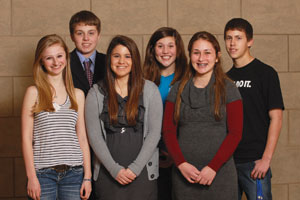The power of Jewish preschool
 When our daughter was preparing to “graduate” from the Jewish Community Center’s Child Development Center, I wrote a column supporting the benefits of sending your child to a Jewish preschool. Now she’s about to be confirmed, and I still believe in the power of Jewish preschool.
When our daughter was preparing to “graduate” from the Jewish Community Center’s Child Development Center, I wrote a column supporting the benefits of sending your child to a Jewish preschool. Now she’s about to be confirmed, and I still believe in the power of Jewish preschool.
I wasn’t even married or a mother when I first began writing about Jewish education. I listened carefully as Hilary Lewis, of blessed memory, and Alan Edelman, who were with what was then known as the Central Agency for Jewish Education, promoted the virtues of Jewish education.
I’m not sure I really needed the pep talk then because I was committed to being an active member of the Jewish community. I had a Bat Mitzvah, was confirmed and loved every minute of the time I spent in BBYO. I wanted any kids I had to attend religious school and have Jewish friends.
As the editor of The Chronicle I have joined Alan, who is now the associate executive director of the Jewish Federation, and the other educators in the city to promote Jewish education. But I have to admit that the fact my daughter is being confirmed this weekend has as much to do with luck as it does my belief in a good Jewish education.
Our daughter really liked, and had a great education, at the Jewish Community Center’s Child Development Center. She made a lot of good friends, and, subsequently, so did my husband and I.
When she “graduated” from pre-K, she was excited to attend religious school. She’d already had a taste of it by attending the family service every Sunday. I think whoever had the idea to serve bagels and begin the morning with a family service was a genius. While I don’t miss having to be somewhere every single Sunday morning, I do miss schmoozing with my friends and the lift that service gave me as I started my Sunday every week.
We got lucky because many of our daughter’s preschool friends also belonged to our congregation. These kids liked being with each other, which probably caused havoc for some of the religious school teachers. By the time the Bar/Bat Mitzvah year rolled around, many of them had known each other for more than 11 years. In fact more than a dozen teens in that class attended the CDC. I watched as many of those kids, now Jewish adults, read the Torah, often while sitting with my friends who I had met through the preschool. It is something I will never forget.
Informal Jewish education also played a role in confirmation. Almost all of these kids my daughter grew up with have experienced some sort of informal Jewish education — camping experiences at the JCC, overnight camp, Rosh Hodesh: It’s a Girl Thing!, NFTY conclaves, B’nai Tzedek shuks and BBYO. These activities — mostly fun and not stuffy school settings — allow kids to see a larger Jewish community than just their own congregations.
I wouldn’t be completely honest if I didn’t mention that there were bumps in the road along the way to confirmation. Being an affiliated member of the Jewish community is expensive. It’s also hard to make sure your child can meet attendance requirements when there are school activities and sports schedules to work around.
As my daughter got older and graduated to classes that no longer included family-type events, I missed the camaraderie of seeing my own friends. I grumbled loudly every single time I had to leave the house after dark to pick up my child.
But no matter how much I complained about her being one of the last ones out the door every Wednesday night, she chose to continue her religious education. She still has friends at religious school. She did the work. She met the requirements. And Sunday she will walk through the sanctuary and stand on the bimah as she did on consecration and at her Bat Mitzvah. She will once again wear a white robe, much like the one she wore at consecration some 10 years. And once again I will sit there, the proud mother, most likely with tears in my eyes.
And it all began 14 years ago at Jewish preschool, which I still highly recommend.


